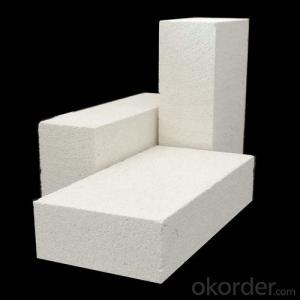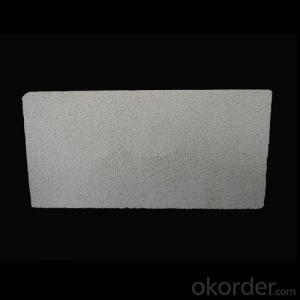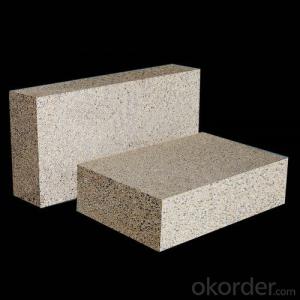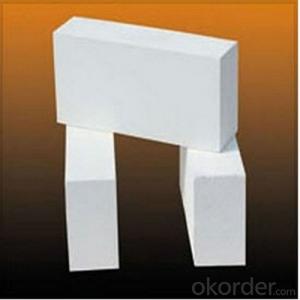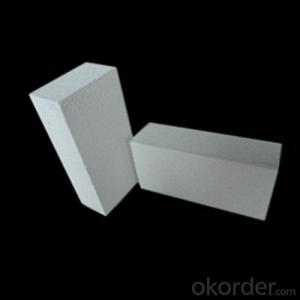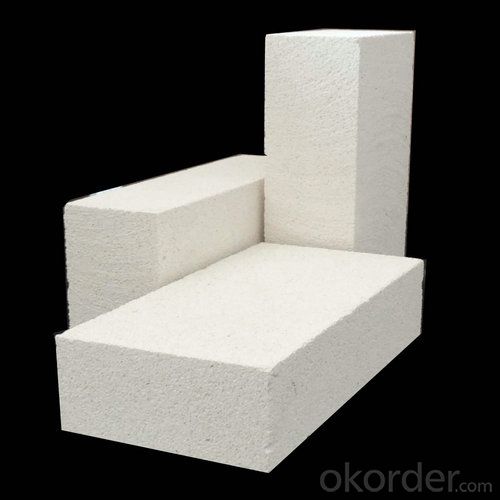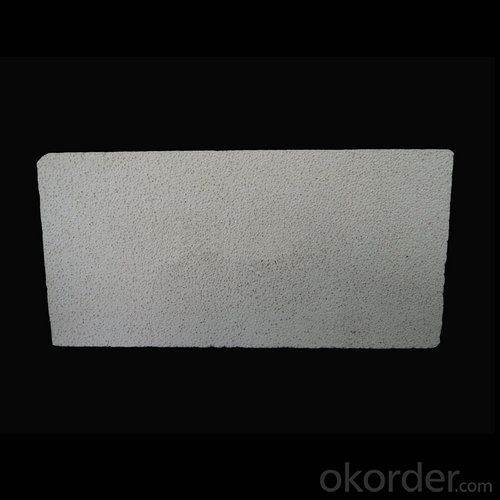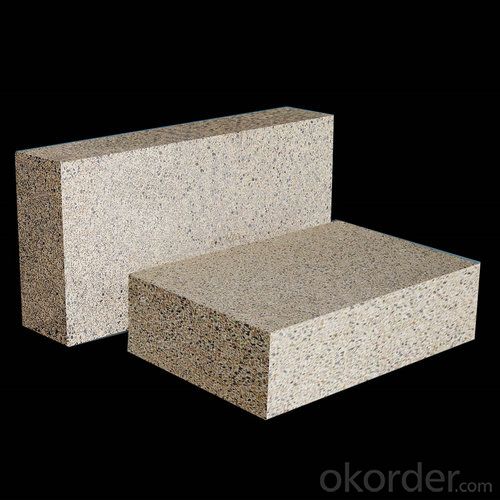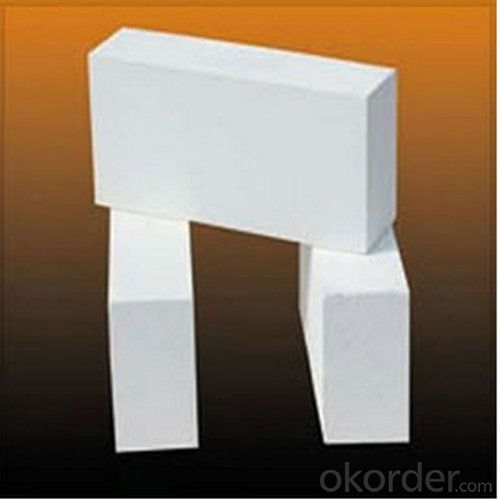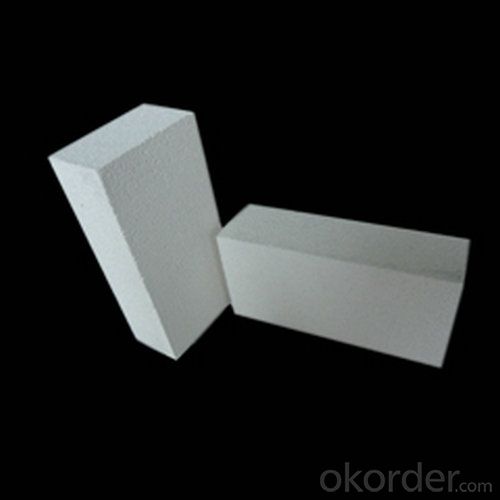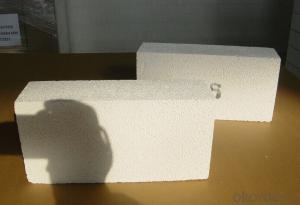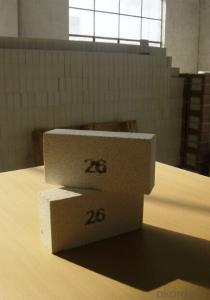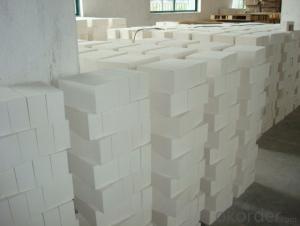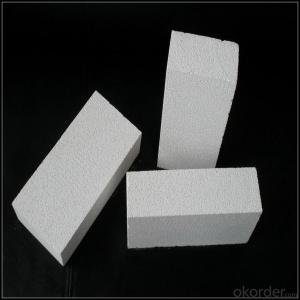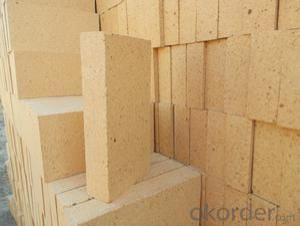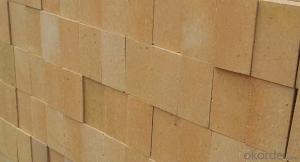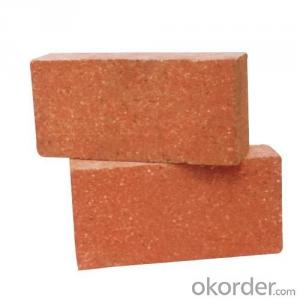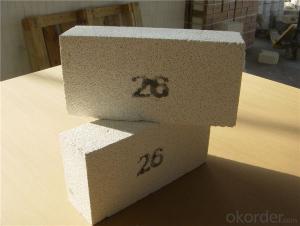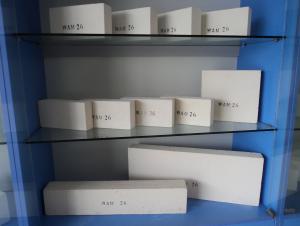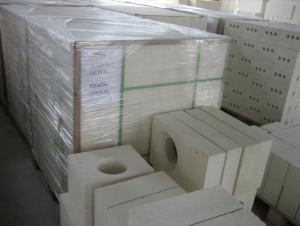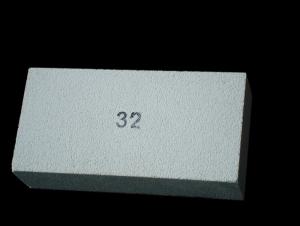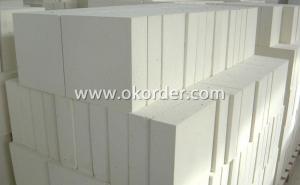Insulating Fire Brick GJM30 in Lightweight Fireclay - Made in China
- Loading Port:
- Tianjin
- Payment Terms:
- TT OR LC
- Min Order Qty:
- 1 m.t.
- Supply Capability:
- 20000 m.t./month
OKorder Service Pledge
OKorder Financial Service
You Might Also Like
Description of Insulating Brick
CMAX Insulating Brick are classified under temperature between 1300℃ to 1700℃, manufactured from high purity alumina clay.
Features of Insulating Brick
Light weight and low thermal conductivity
Low heat storage
Low iron and impurities
High thermal shock resistance
Specifications for Insulating Fire Brick
Applications of Insulating Brick
CMAX Insulating Brick can be used as a hot face lining directly exposed to the heat or as a backup insulation layer in iron and steel mills, non-ferrous foundries, petrochemical, ceramic, glass.
Specifications of Insulating Brick
Type No. |
Density |
Compressive Strength |
Rupture Strength | % Linear Change on Reheating | Thermal Shock Resistance, Times | Heat Conductive Cofficient | Al2O3 | Fe2O3 |
DJM-23 | 0.60 | 1.3 | 1.0 | 1230×12-0.5 | ≥20 | 400°C0.15 | 40 | 0.70 |
DJM-26 | 0.80 | 1.8 | 1.4 | 1400×12-0.5 | >20 | 600°C0.25 | 55 | 0.70 |
DJM-28 | 0.90 | 2.2 | 1.7 | 1510×12-1.0 | >20 | 600°C0.34 | 65 | 0.60 |
DJM-30 | 1.0 | 2.50 | 2.10 | 1600×12-1.0 | >20 | 600°C0.43 | 74 | 0.50 |
DJM-32 | 1.2 | 3.50 | 2.50 | 1650×12-1.0 | >20 | 600°C0.50 | 76 | 0.40 |
Images of Insulating Brick
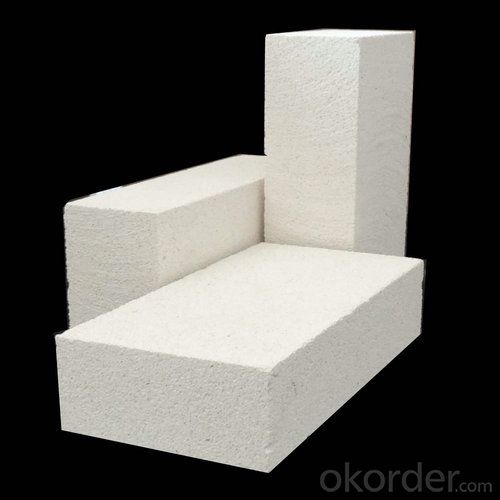
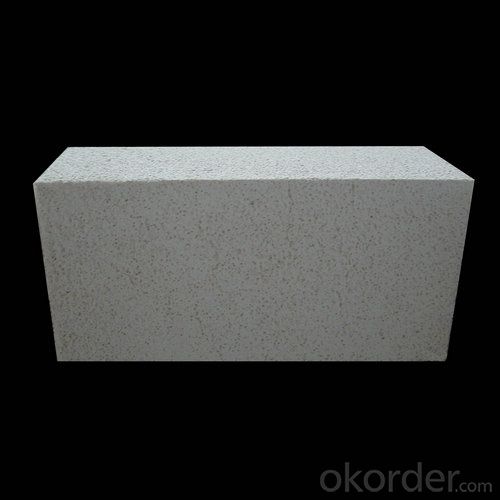
FAQ of Insulating Brick
1. Which products do you have?
We have all kinds of refractory brick, castable, mortar, cement, ceramic fiber products, etc.
Or you could browse our products to choose what you need.
2. Can you give me a general idea of the specification and technical data of your products?
CNBM offer a range of refractory and insulation products. We provide refractory bricks, monolithic refractories as well as ceramic fiber products. And On your given shapes, drawings or description, we are producing refractories with all sizes and shapes, resistant to temperature from 800 °C till 1800 °C, using various machines and equipments for cutting, grinding, drilling, polishing, shaping processes.
Every refractory product by CNBM is of superior quality. Lesser refractory products can not approach. CNBM utilizes proprietary testing methods, testing for chemical content, density, apparent porosity, cold crush strength and modulus of rapture. With stringent quality control, you can count on CNBM products to exceed refractory industry standards and your expectations.
3. Can you give me a brief introduction of the application of your products?
We are mainly specializing in the refractory materials in iron and steel, cement, glass, ceramics, petrochemical, electric power Industry, etc.
4. If I need your offer, what information do you need?
In order to choose suitable products, it will be appreciated to provide us the information, such us specification, technical data, order quantity, products application etc.
If any question, please contact us freely.
- Q: Do insulating fire bricks require any special curing or firing temperature profiles?
- Yes, insulating fire bricks do require special curing or firing temperature profiles. These bricks are typically made from lightweight refractory materials, which need to be slowly heated and cooled to avoid cracking or damage. The curing process involves gradually increasing the temperature over several hours and holding it at a specific level for a certain period. This allows the bricks to undergo physical and chemical changes, ensuring their optimal performance and durability in high-temperature applications.
- Q: Are insulating fire bricks lightweight or heavy?
- Insulating fire bricks possess a lightweight quality, a result of their deliberate design to exhibit high insulation and low density. Their composition primarily consists of lightweight materials like expanded clay, perlite, and vermiculite, which further enhance their weightlessness. Consequently, these bricks prove to be more manageable and easier to install when compared to conventional heavy fire bricks. Nonetheless, insulating fire bricks manage to maintain exceptional thermal insulation capabilities, rendering them well-suited for a range of applications, such as kilns, furnaces, and fireplaces.
- Q: How do insulating fire bricks affect the overall sustainability of a structure?
- Insulating fire bricks play a crucial role in enhancing the overall sustainability of a structure. These bricks are designed to have low thermal conductivity, which helps in minimizing heat loss from the building. By providing effective insulation, they contribute to energy efficiency by reducing the need for excessive heating or cooling. This, in turn, leads to lower energy consumption and reduced carbon emissions, making the structure more environmentally friendly. Furthermore, insulating fire bricks have excellent durability, enabling them to withstand high temperatures and extreme conditions, resulting in longer-lasting structures that require fewer repairs and replacements. Overall, insulating fire bricks enhance the sustainability of a structure by improving energy efficiency and durability, leading to reduced environmental impact and long-term cost savings.
- Q: Are insulating fire bricks chemically resistant?
- Insulating fire bricks exhibit a wide resistance to numerous substances chemically. These bricks are typically composed of top-notch refractory materials, including alumina, silica, or a combination of the two. These materials possess exceptional chemical resistance, thereby endowing insulating fire bricks with formidable protection against the corrosive effects of diverse chemicals. Nevertheless, it is essential to acknowledge that the chemical resistance of insulating fire bricks may vary depending on their distinct composition and manufacturing techniques. While they generally withstand most chemicals, there exists a possibility of certain aggressive chemicals or extreme circumstances potentially causing the degradation or erosion of the bricks over time. To guarantee the utmost chemical resistance of insulating fire bricks, it is advised to consult the manufacturer's specifications or seek expert counsel pertaining to specific applications. Such measures will ensure that the bricks are suitable for the intended chemical environment and will consistently perform as desired throughout their expected lifespan.
- Q: Can insulating fire bricks be used in chimneys and flues?
- Insulating fire bricks are specifically designed for high-temperature applications and are often used in furnaces, kilns, and other industrial settings. While they do possess excellent insulating properties, they may not be the best choice for chimneys and flues in residential or commercial buildings. The main reason for this is that insulating fire bricks are not as durable and heat-resistant as other materials specifically designed for chimney and flue construction. They may crack or break when exposed to the extreme heat and rapid temperature changes that occur in chimneys. Additionally, these bricks are not typically designed to withstand the corrosive effects of flue gases, which can lead to their degradation over time. When it comes to chimneys and flues, it is generally recommended to use materials such as clay flue liners, stainless steel, or refractory bricks that are specifically manufactured for these applications. These materials are better suited to handle the high temperatures, corrosive gases, and rapid thermal expansion and contraction that occur in chimneys. It is important to consult with a professional chimney or flue specialist who can advise on the appropriate materials to use based on the specific requirements and conditions of your chimney or flue system.
- Q: What material is good for indoor thermal insulation?
- Own home, if the south, hot summer and cold winter zone, with inorganic insulation mortar or polystyrene particles insulation mortar, the effect is very good;
- Q: Can insulating fire bricks be used in rocket stove designs?
- Insulating fire bricks are capable of being incorporated into the designs of rocket stoves. Rocket stoves are renowned for their efficient combustion and heat transmission, and the utilization of insulating fire bricks can enhance this level of performance. These bricks are produced from lightweight materials that possess excellent insulating properties, allowing them to effectively retain and reflect heat. The combustion chamber of a rocket stove is typically lined with insulating fire bricks in order to maximize the transfer of heat to the cooking surface or the area being heated. The bricks aid in the retention of heat within the combustion chamber, ensuring that a greater portion of the energy generated from the burning fuel is utilized to heat the cooking surface, rather than being dissipated into the surrounding environment. Moreover, insulating fire bricks are capable of enduring high temperatures, making them an ideal choice for inclusion in rocket stove designs. They are specifically engineered to withstand the intense heat generated by the combustion process, guaranteeing that the bricks will not fracture or shatter under such circumstances. In conclusion, the incorporation of insulating fire bricks into the designs of rocket stoves can enhance the efficiency and heat transmission of the stove, resulting in a more efficient and sustainable solution for cooking or heating purposes.
- Q: Are insulating fire bricks suitable for use in kilns and furnaces?
- Yes, insulating fire bricks are suitable for use in kilns and furnaces. Insulating fire bricks are designed to provide excellent thermal insulation, making them ideal for applications that require high temperatures, such as in kilns and furnaces. They have low thermal conductivity which helps to minimize heat loss and improve energy efficiency. Additionally, insulating fire bricks are lightweight and durable, allowing for easy installation and long-lasting performance in high-temperature environments. They are resistant to thermal shock and can withstand rapid temperature changes, making them a reliable choice for kilns and furnaces. Overall, insulating fire bricks are an excellent option for providing insulation and maintaining high temperatures in kilns and furnaces.
- Q: Can insulating fire bricks be used for both residential and commercial purposes?
- Yes, insulating fire bricks can be used for both residential and commercial purposes. These bricks are designed to withstand high temperatures and provide excellent insulation, making them suitable for various applications such as lining fireplaces, kilns, furnaces, and industrial ovens in both residential and commercial settings.
- Q: Can insulating fire bricks be used in the construction of crucible furnaces?
- Yes, insulating fire bricks can be used in the construction of crucible furnaces. Insulating fire bricks are designed to withstand high temperatures and provide excellent insulation properties, making them suitable for use in crucible furnaces. These bricks are made from lightweight materials such as alumina and silica, which have low thermal conductivity and can effectively retain heat. By using insulating fire bricks, the crucible furnace can achieve higher energy efficiency, faster heating times, and better temperature control. Additionally, these bricks are also resistant to thermal shock, ensuring they can withstand the intense heat generated in the crucible furnace. Overall, insulating fire bricks are a popular choice for constructing crucible furnaces due to their excellent thermal insulation properties and ability to withstand high temperatures.
Send your message to us
Insulating Fire Brick GJM30 in Lightweight Fireclay - Made in China
- Loading Port:
- Tianjin
- Payment Terms:
- TT OR LC
- Min Order Qty:
- 1 m.t.
- Supply Capability:
- 20000 m.t./month
OKorder Service Pledge
OKorder Financial Service
Similar products
Hot products
Hot Searches
Related keywords
